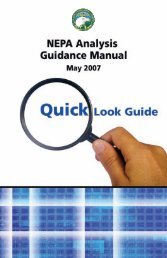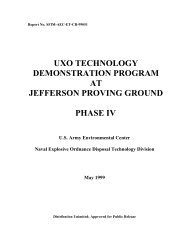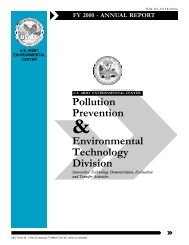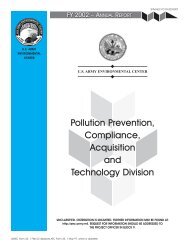(MRAP) Vehicle Program - U.S. Army Environmental Center
(MRAP) Vehicle Program - U.S. Army Environmental Center
(MRAP) Vehicle Program - U.S. Army Environmental Center
Create successful ePaper yourself
Turn your PDF publications into a flip-book with our unique Google optimized e-Paper software.
<strong>Army</strong> <strong>MRAP</strong> <strong>Vehicle</strong> <strong>Program</strong> <strong>Program</strong>matic <strong>Environmental</strong> Assessment December 2010<br />
<strong>MRAP</strong> vehicle testing utilized existing test courses and ranges. These test areas have<br />
already been used during other vehicle test exercises. In addition, these areas are<br />
maintained to mitigate the negative impacts from vehicle activities. No new test ranges<br />
or courses have been built for <strong>MRAP</strong> tests. As a result, <strong>Army</strong> <strong>MRAP</strong> testing activities<br />
have had a negligible additional impact on land use.<br />
<strong>MRAP</strong> training and deprocessing activities utilize existing structures and outdoor storage<br />
areas. Driver’s training occurs on existing training areas and ranges. As a result, no<br />
building of new structures was required. Based upon the use of these existing<br />
structures, areas and ranges, <strong>Army</strong> <strong>MRAP</strong> training and fielding have negligible additional<br />
impact on land use.<br />
<strong>MRAP</strong> vehicles will be fielded to sites with existing maintenance and storage areas that<br />
are already in use for other wheeled tactical vehicles or weapon systems. At a<br />
programmatic level, it is not anticipated that <strong>MRAP</strong> fielding will have a significant<br />
additional impact on land use resources. However, the <strong>MRAP</strong> CONUS fielding plan has<br />
not yet been finalized. When the information becomes available, <strong>Army</strong> fielding sites will<br />
be responsible to determine how <strong>MRAP</strong> fielding will impact their land use. A site‐<br />
specific NEPA analysis and documentation may be required to address fielding activities<br />
that are expected to have a significant impact on land use, including the need for<br />
additional or expanded facilities and ranges. JPO <strong>MRAP</strong> will provide any required and<br />
requested system information to the installation personnel in support of document<br />
development.<br />
<strong>MRAP</strong> vehicles will be fielded to existing testing, training, and fielding sites which<br />
already house ground weapon systems including some or all of the following: Bradley<br />
Fighting <strong>Vehicle</strong>s, Stryker <strong>Vehicle</strong>s, Heavy Tactical Trucks, Medium Tactical Trucks, and<br />
Light Tactical Trucks. The impacts of the <strong>MRAP</strong> are anticipated to be similar to these<br />
existing vehicles which have not shown a significant impact to the environment when<br />
used in accordance with Technical Manual instructions and established installation<br />
procedures. Therefore, no additional direct, indirect or cumulative impacts to land<br />
resources are anticipated or have yet been reported for <strong>Army</strong> <strong>MRAP</strong> life‐cycle activities.<br />
5.3 Cultural Resources<br />
5.3.1 Production<br />
The majority of <strong>MRAP</strong> vehicle production occurs in existing production facilities. Any<br />
new building construction occurred on previously disturbed land. No cultural resources<br />
have come in direct contact with the production processes and no known impacts have<br />
occurred to cultural resources.<br />
UNCLASSIFIED 26







